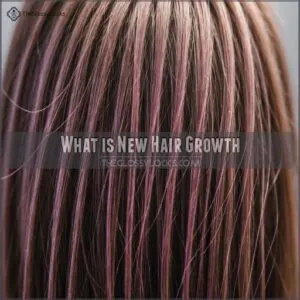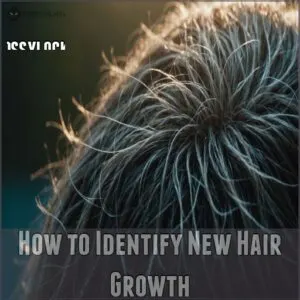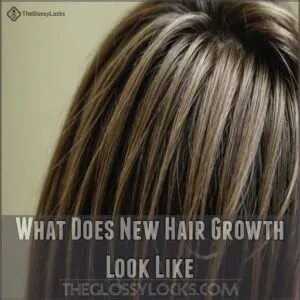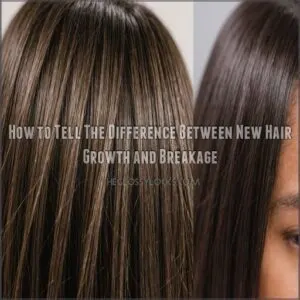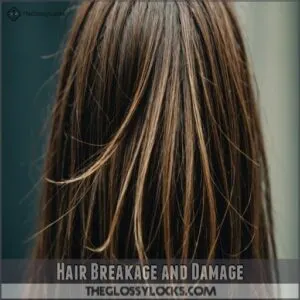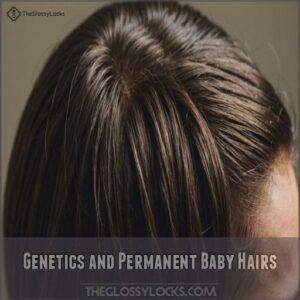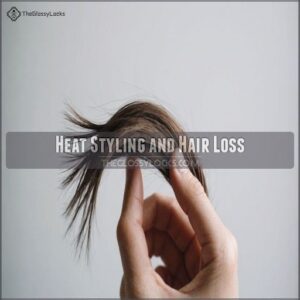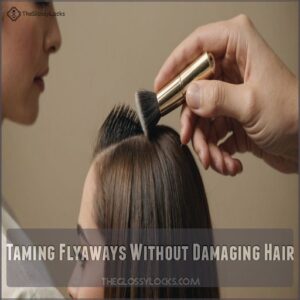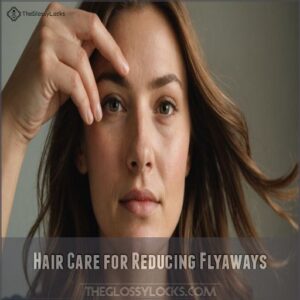This site is supported by our readers. We may earn a commission, at no cost to you, if you purchase through links.
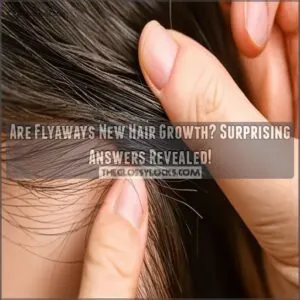
While some of those shorter strands might be new hair growth playing catch-up with your longer locks, they could also be signs of breakage from tight hairstyles or heat damage.
Think of them as your hair’s way of sending you mixed signals – like getting both good news and bad news at once.
You’ll often spot new growth as short, fine hairs with tapered ends near your scalp, while breakage typically shows up as rough, split-ended strands along your hairline.
Understanding the difference is key to giving your hair exactly what it needs.
Table Of Contents
- Key Takeaways
- The Mystery of Flyaways
- New Hair Growth Signs and Symptoms
- Causes of Flyaways Vs New Hair Growth
- Taming Flyaways Without Damaging Hair
- Hair Care for Reducing Flyaways
- Embracing Flyaways as a Natural Part of Hair Growth
- Frequently Asked Questions (FAQs)
- Are my flyaways new growth or breakage?
- What are the signs of new hair growth?
- Can new hair growth look like frizz?
- Why do I suddenly have so many flyaways?
- Can pregnancy hormones cause more flyaways than usual?
- Do certain hair types get more flyaways?
- Why do flyaways appear more in humid weather?
- Are supplements effective for managing stubborn flyaways?
- Does hair color treatment affect flyaway frequency?
- Conclusion
Key Takeaways
Here are 4 key takeaways about flyaways and new hair growth: Hair breakage can cause hair to appear shorter, and preventing split ends is crucial, as explained in the guide on why hair gets shorter
- Flyaways can be a sign of dry and brittle hair, which often leads to breakage, as discussed in what does damaged hair look like here. Flyaways can be signs of new growth or breakage – examine the hair ends closely to tell the difference.
- New hair growth typically appears as short, fine hairs with tapered ends near your scalp or hairline.
- Your styling habits, genetics, and overall hair health all play a role in how many flyaways you have.
- While you can use products and techniques to tame flyaways, embracing them as part of your hair’s natural texture can be liberating.
The Mystery of Flyaways
You’ve noticed those pesky little hairs sticking up from your scalp, but what’s the deal with them?
Let’s unravel the mystery of flyaways and find out if they’re just rebellious strands or signs of new growth.
What Are Flyaways and Baby Hairs
Ever caught sight of those pesky little hairs sticking out from your ‘do?
You’re not alone!
Flyaways and baby hairs are those fine, wispy strands that seem to have a mind of their own.
They’re like rebellious teenagers of the hair world – short, stubborn, and always causing a fuss.
Whether framing your face or popping up along your hairline, these tiny troublemakers can be a real head-scratcher for many of us.
Causes of Flyaways and Baby Hairs
Flyaways and baby hairs can be pesky little rebels in your hair game.
They’re often caused by a mix of factors: hair breakage from overdoing it with heat styling or tight ‘dos, using the wrong shampoo can exacerbate this, such as those that don’t contain key ingredients for hair growth, new growth sprouting up after hair loss, or simply your genetic blueprint.
Your hair care routine plays a big role too.
Sometimes, it’s just your hair’s way of keeping things interesting!
Differences Between Flyaways and Baby Hairs
Many folks confuse flyaways with baby hairs, but they’re not quite the same thing.
Flyaways are often longer, frizzier strands that stick out from your main hair.
Baby hairs, on the other hand, are those short, fine hairs along your hairline.
While flyaways can be a sign of damage or new growth, baby hairs are typically permanent and part of your natural hair texture.
The visibility of hair on an ultrasound scan can be affected by various factors, such as gestational age and hormones.
New Hair Growth Signs and Symptoms
Ever noticed those pesky little hairs sticking up all over your head?
You might be experiencing new hair growth, but don’t break out the party hats just yet – it’s not always easy to tell if those flyaways are fresh sprouts or just rebellious strands.
What is New Hair Growth
You’ve solved the flyaway mystery, but now you’re wondering about new hair growth.
It’s a natural part of your hair’s life cycle.
New strands sprout from your scalp, replacing old ones that have fallen out.
This process happens in phases, with each hair going through growth, rest, and shedding periods.
Your hair’s growth speed can vary, influenced by factors like genetics, diet, and overall health.
How to Identify New Hair Growth
Peering at your scalp in the mirror, you might spot signs of new hair growth. Identifying these fresh strands can be tricky, but there are telltale signs to look out for:
- Short, fine hairs along your hairline
- Fuzzy texture near the roots
- Increased hair density in thinning areas
- Baby hairs that seem to pop up overnight
Don’t fret if you see these wispy newcomers – they’re often a sign your hair’s growth cycle is in full swing!
What Does New Hair Growth Look Like
New hair growth often looks like short, fine strands popping up along your hairline or part.
These little hairs might seem a bit unruly, standing up or sticking out.
They’re usually softer and thinner than your existing hair, and can vary in color.
As they grow, you’ll notice them blending in with the rest of your locks.
Keep an eye out for these telltale signs of fresh growth!
How to Tell The Difference Between New Hair Growth and Breakage
Telling new growth from breakage can be tricky.
Look closely at the ends – new growth has tapered tips, while breakage is blunt.
Check your scalp health too. If you’re seeing lots of short hairs all over, it might be breakage from a harsh hair care routine. But if they’re mainly around your hairline or part, you’re probably sporting fresh growth.
Your hair’s texture can also be a clue.
Causes of Flyaways Vs New Hair Growth
Ever looked in the mirror and wondered if those pesky flyaways are just new hair growth?
You’re not alone – let’s unravel the mystery behind those stubborn strands and figure out what’s really going on up there.
Hair Breakage and Damage
Hair breakage and damage often masquerade as new growth, fooling even the savviest hair enthusiasts.
Ever noticed those pesky flyaways that just won’t behave? They might be crying out for help!
Excessive heat styling, harsh chemical treatments, and tight hairstyles can wreak havoc on your locks, causing them to snap and fray.
Fortunately, there are specialized hair breakage products designed to target these issues.
The result? A halo of short, unruly strands that stick out like a bad hair day gone wild.
Genetics and Permanent Baby Hairs
Ever wondered why those pesky baby hairs won’t grow out?
Turns out, genetics play a big role in your hair’s texture and growth patterns.
Your family history can determine whether you’ll have permanent baby hairs.
Here’s what you need to know:
- Baby hairs can be hereditary
- They’re often finer and shorter than other hairs
- Some people naturally have more baby hairs than others
Don’t sweat it if you’ve got ’em – they’re just part of your unique hair story!
Heat Styling and Hair Loss
While genetics play a role, your styling habits can be a game-changer for your locks.
Ever noticed more flyaways after a hot date with your flat iron?
Heat styling and hair loss often go hand in hand.
Let’s break it down:
| Heat Styling Method | Damage Level | Hair Loss Risk |
|---|---|---|
| Flat Iron | High | Moderate |
| Curling Wand | Medium | Low |
| Blow Dryer | Low-Medium | Low |
| Hot Rollers | Low | Very Low |
| Straightening Brush | Medium | Low-Moderate |
To prevent heat damage and promote healthier hair growth, using a high-quality heat protectant for curly hair is crucial. Remember, heat protectants are your hair’s best friend!
Taming Flyaways Without Damaging Hair
You’ve battled those pesky flyaways, but don’t worry – taming them doesn’t have to be a hair-raising experience.
Let’s explore some gentle techniques to smooth those stubborn strands without causing damage, so you can rock that sleek look with confidence.
Using Headbands and Bobby Pins
Taming those pesky flyaways doesn’t have to be a hair-raising experience, especially if you’re mindful of headphone hair damage caused by headphone headband pressure.
Headbands and bobby pins are your secret weapons for a sleek look.
Here are three quick tricks to try:
- Rock a trendy wide headband to smooth down baby hairs
- Create an invisible hold with crisscrossed bobby pins
- DIY a chic hair accessory using colorful pins for both style and control
These easy hacks will have you feeling like a hair-raising experience, no time!
Pomade and Hair Gel for Taming Flyaways
Bobby pins are great, but let’s talk about some slick solutions for those pesky flyaways.
Pomade and hair gel can be your secret weapons.
These products offer stronger hold, perfect for taming those wild strands.
Pomade works wonders for a sleek look, while gel gives you more control for intricate styles.
Just remember, a little goes a long way – you don’t want to end up with a helmet head!
Cultural Sensitivity in Styling Baby Hairs
When styling baby hairs, it’s important to understand the cultural significance behind different techniques.
"Laying edges" has deep roots in Black hair culture, and thoughtful consideration is needed before adopting these methods.
Here are key points to remember:
- Research the historical context of hair styling techniques
- Consider whether your styling choices respect cultural traditions
- Learn from communities where these practices originated
This awareness helps create a more respectful beauty community.
Hair Care for Reducing Flyaways
If you’ve been fighting a daily battle with those pesky flyaway hairs, you’re not alone in the struggle to tame your mane.
You’ll be happy to know there are several proven ways to reduce these stubborn strands without damaging your hair or spending a fortune on fancy products.
Reducing Heat Styling and Tight Hairstyles
Heat styling tools might feel like your best friends, but they’re often secret troublemakers for your hair.
Instead of cranking up that flat iron daily, try air-drying or using heatless styling methods like braiding damp hair overnight.
And those super-tight ponytails? They’re doing you no favors. Opt for looser styles or soft scrunchies to prevent breakage and give your strands the freedom they deserve.
Regular Trims for Healthy Hair Growth
Regular trims aren’t just a beauty ritual – they’re your secret weapon against those pesky flyaways.
You’ll want to schedule cuts every 8-12 weeks to remove split ends before they travel up your hair shaft.
Think of it like pruning a plant: trimming encourages healthy growth and prevents breakage.
Using the right products, like a flyaway serum treatment, can also help to keep your hair looking its best.
Plus, maintaining a consistent trim schedule helps your hair look fuller and more polished over time.
Hair Repair Treatments for Damaged Hair
Your hair’s been through the salon spin cycle, and now it’s time for some TLC.
After trimming those ends, let’s focus on repairing what’s left with some powerhouse treatments.
To prevent future damage, check out tips for how to repair damaged hair.
- Deep conditioning masks work like a time machine for damaged strands
- Protein treatments rebuild your hair’s structure from the inside out
- Bond-building products reconnect broken hair bonds
- Leave-in conditioners create an invisible shield against future damage
Let’s get your hair back to its glory days!
Embracing Flyaways as a Natural Part of Hair Growth
You’ll be amazed to discover that those pesky flyaways can be nourished and strengthened with natural oils like castor oil rich in vitamin E and fatty acids, by exploring hair growth remedies. that those pesky flyaways might actually be a sign of your hair’s natural growth cycle and energy.
While you’ve probably spent countless hours trying to tame these rebellious strands, which often pop up after using heat styling tools that can cause hair heat damage prevention.
Accepting Flyaways as a Sign of Healthy Hair
Those pesky flyaways sprouting from your scalp aren’t just random rebels – they’re often signs of new growth and a thriving hair journey.
While it’s tempting to fight them, these short strands can indicate your hair is actively growing and regenerating.
Think of them as tiny victory flags celebrating your hair’s health.
Instead of stressing over perfect smoothness, recognize these natural sprouts as proof your hair care routine is working.
Finding Beauty in Imperfect Hair
Perfect hair is a myth – and that’s actually great news! Once you start seeing those flyaways as part of your unique hair story, you’ll feel more confident rocking your natural look. Here’s why embracing your hair’s quirks makes sense:
- Every flyaway represents resilience and growth
- Using a hair growth serum can be helpful in promoting hair health
- "Perfect" hair often means over-styling
- Natural hair movement shows your hair is healthy and alive
Rather than fighting those little wisps, think of them as your hair’s personality showing through
Embracing Individuality in Hair Texture
Hair texture comes in countless beautiful variations, and these differences make each person’s hair story unique.
Instead of fighting against your natural texture, why not celebrate what makes your hair special?
Whether you’ve got curls, waves, or pin-straight strands, embracing your hair’s natural tendencies – including those flyaways – can be surprisingly liberating.
It’s time to work with your hair’s personality, not against it.
Frequently Asked Questions (FAQs)
Are my flyaways new growth or breakage?
Looking at your hair in bright light, examine the ends: blunt, thick tips usually signal breakage, while tapered, fine ends suggest new growth.
Without seeing your hair personally, I can’t definitively tell which you have.
What are the signs of new hair growth?
You’ll spot new hair growth as tiny, fine hairs emerging along your hairline or part.
They’re often soft and wispy, like a baby’s hair.
These sprouts may stick up or curl differently from your existing locks.
Can new hair growth look like frizz?
New hair growth can masquerade as frizz.
Those pesky little hairs sticking up might be fresh sprouts.
It’s tricky to tell the difference, but healthy growth often feels softer and less wiry than typical frizz.
Why do I suddenly have so many flyaways?
Sudden flyaways can be triggered by various factors.
Hair damage from heat styling, hormonal changes, or even the weather can cause these pesky strands.
They might also signal new growth, especially if you’ve recently changed your hair care routine.
Can pregnancy hormones cause more flyaways than usual?
Yes, pregnancy hormones can lead to more flyaways.
During pregnancy, your hair typically grows thicker and faster.
After giving birth, these extra hairs start shedding, resulting in more noticeable flyaways and baby hairs.
Do certain hair types get more flyaways?
Like temperamental wildflowers, some hair types are more prone to flyaways.
You’ll find fine, curly, or damaged hair often sprouts more stubborn wisps.
Factors like humidity, styling habits, and overall hair health also play a role in flyaway frequency.
Why do flyaways appear more in humid weather?
Flyaways become more noticeable in humid weather because your hair absorbs moisture from the air.
This causes the hair shaft to swell and frizz, making those pesky little strands stick out even more.
It’s like your hair’s having a bad hair day!
Are supplements effective for managing stubborn flyaways?
Chasing the dream of taming those pesky flyaways? You’re not alone.
While supplements can boost overall hair health, they’re not a magic wand for stubborn flyaways.
Focus on proper hair care and styling techniques for better results.
Does hair color treatment affect flyaway frequency?
Yes, hair color treatments can increase flyaways.
The chemicals in dye can damage your hair’s structure, making it more prone to frizz.
To keep your mane smooth, use color-safe products and deep conditioning treatments regularly.
Conclusion
Flyaways: friend or foe? Now you know they’re a bit of both.
Whether they’re signs of new growth or breakage, these wispy strands are part of your hair’s journey.
Embrace the good, address the bad, and remember that perfect hair is a myth.
So next time you wonder, "Are flyaways new hair growth?", you’ll have the tools to decode your hair’s secret language.
Treat your locks with care, celebrate their uniqueness, and rock those baby hairs with confidence.
Your hair’s story is uniquely yours – flyaways and all!


